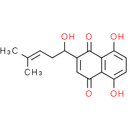Description
(-)-Alkannin, found in Alkanna tinctoria, is used as a food coloring. (-)-Alkannin shows anticancer activity, arrests cell cycle, and induces apoptosis. (-)-Alkannin improves hepatic inflammation in a Rho-kinase pathway.
Product information
CAS Number: 517-88-4
Molecular Weight: 288.30
Formula: C16H16O5
Chemical Name: 5, 8-dihydroxy-2-[(1S)-1-hydroxy-4-methylpent-3-enyl]naphthalene-1, 4-dione
Smiles: CC(C)=CCC(O)C1=CC(=O)C2=C(C1=O)C(O)=CC=C2O
InChiKey: NEZONWMXZKDMKF-UHFFFAOYSA-N
InChi: InChI=1S/C16H16O5/c1-8(2)3-4-10(17)9-7-13(20)14-11(18)5-6-12(19)15(14)16(9)21/h3,5-7,10,17-19H,4H2,1-2H3
Technical Data
Appearance: Solid Power
Purity: ≥98% (or refer to the Certificate of Analysis)
Solubility: DMSO : 33.33 mg/mL (115.61 mM; Need ultrasonic)
Shipping Condition: Shipped under ambient temperature as non-hazardous chemical or refer to Certificate of Analysis
Storage Condition: Dry, dark and -20 oC for 1 year or refer to the Certificate of Analysis.
Shelf Life: ≥360 days if stored properly.
Stock Solution Storage: 0 - 4 oC for 1 month or refer to the Certificate of Analysis.
Drug Formulation: To be determined
HS Tariff Code: 382200
References:
- Hosokawa Y, et al. Alkannin inhibits CCL3 and CCL5 production in human periodontal ligament cells. Cell Biol Int. 2016 Dec;40(12):1380-1385.
- Huu Tung N, et al. Naphthoquinone components from Alkanna tinctoria (L.) Tausch show significant antiproliferative effects on human colorectal cancer cells. Phytother Res. 2013 Jan;27(1):66-70.
- Xue W, et al. Alkannin Inhibited Hepatic Inflammation in Diabetic Db/Db Mice. Cell Physiol Biochem. 2018;45(6):2461-2470.
Products are for research use only. Not for human use.
Payment & Security
Your payment information is processed securely. We do not store credit card details nor have access to your credit card information.


